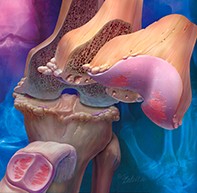Peer Reviewed
Feature Article Pain medicine
Osteoarthritis: factors associated with pain and implications for therapy
Abstract
Osteoarthritis is the most common musculoskeletal cause of disability in western society. It should be regarded as an umbrella term for several pathways that result in pain and cartilage loss, which is leading to the development of pathophysiology-specific therapies. It is therefore important to try and pinpoint the causes of pain so treatment plans can be personalised for each affected patient.
Key Points
- Osteoarthritis is an umbrella term for several active processes that lead to pain and/or cartilage loss.
- X-rays give limited information about osteoarthritis and only provide marginal assistance at tailoring therapy for the individual. MRI has great potential in this regard but targeted trials have been few to date.
- Bone marrow lesions and cartilage defects have independent associations with pain in people with osteoarthritis.
- Obesity and weak muscles are also independently associated with pain in osteoarthritis; therefore, weight loss and strengthening and aerobic exercises may help improve symptoms.
- Pain in osteoarthritis is also modified by central factors such as depression, catastrophisation, self-efficacy and a positive attitude.
- Targeting subchondral bone has the most potential to modify osteoarthritis given the failure of most therapies aimed at cartilage.
Picture credit: © Phototake/Bodell Communications, Inc/Diomedia.com
Purchase the PDF version of this article
Already a subscriber? Login here.

